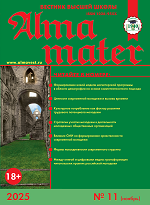https://doi.org/10.20339/AM.2-18.050
V.I. Afonsky is Cand.Sci. (Pedagogy), doc. at Tula State Pedagogical University n.a. L.N. Tolstoy
e-mail: phileo@tsput.ru
Analyzed are value features of physical breeding as complex pedagogical process in contemporary culture of Russia. Goals and objectives of physical breeding, it’s value connotations, determining motivation, willful and mental attitudes to activity in the system of individual and group studies are examined. On the basis of analysis of state documents and regulations shown is, that physical breeding in contemporary Russia is aimed at harmonious perfection of personality, and also contributes to it’s interests, growth and success in professional activity. Presented is dialectical relationship between physical culture and physical breeding.
Key words: physical culture, physical breeding, corporeality, spirituality, kallogate principle, synthesis of physical and spiritual in physical breeding, activity, personal factor in physical breeding.
References
1. Maximenko, A.M. Fundamentals of the theory and methodology of physical culture. Moscow, 2001.
2. Ponomaryev, N.I. Sport as social and pedagogical phenomenon. Leningrad, 1984.
3. Theory and methodology of physical culture. Moscow, 2004.
4. Federal Law “On Physical Culture and Sport in the Russian Federation”. Moscow, 2006.
5. Glantz, T. Physical education as nostalgia for non-existent national body. URL: http://www.nlobooks.ru/node/3717#sthash.feTNcFk6.dpuf
6. Physical culture of student’s personality. URL: https://studme.org/152905274073/meditsina/fizicheskaya_kultura_lichnosti_studenta
7. Meleshko, E.D., Afonsky, V.I. Physical culture as a value. Historical, philosophical, political and legal sciences, cultural studies and art history. Questions of theory and practice. 2016, no. 3-1 (65), pp. 130–132.











.png)






